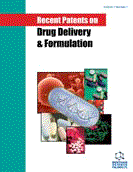Abstract
Aims and Background: The objective of the study was to improve the bioavailability of poorly soluble repaglinide (RPG) by preparing nanosuspension with poloxamer 188 using high pressure homogenization (HPH). The recent patents on nanocrystals (US20150337006A1) facilitated selection of drug and polymer.
Methods: Suspensions containing dissimilar sized particles were prepared by ultrasonication and HPH. The prepared aqueous suspensions were lyophilized and then characterized. Further, the dried aqueous suspensions were evaluated for drug content, solubility, in vitro dissolution, oral bioavailability study and stability study.
Results: RPG nanoparticles size, polydispersity index (PDI) and zeta potential were found to be 280.8 ± 15 nm, 0.279 ± 0.04 and - 25.81 ± 1.6mV, respectively. DSC and XRD results showed that RPG particles in aqueous suspensions were present in a crystalline state; however, RPG nanoparticles exhibited decreased lattice energy due to smaller particle size. Nanoparticles prepared by HPH exhibited significant improvements in solubility and dissolution rate. Oral bioavailability was found to be enhanced by 1.93 fold in comparison with that of plain RPG. The nanosuspension was found to be stable when stored at 5°C ± 3°C.
Conclusion: The outcomes of the study revealed significant enhancement in dissolution rate and oral bioavailability of RPG due to size reduction to nano range by HPH.
Keywords: Repaglinide, nanosuspension, high pressure homogenization, solubility enhancement, dissolution rate enhancement, oral bioavailability enhancement.
Graphical Abstract
 30
30 3
3














